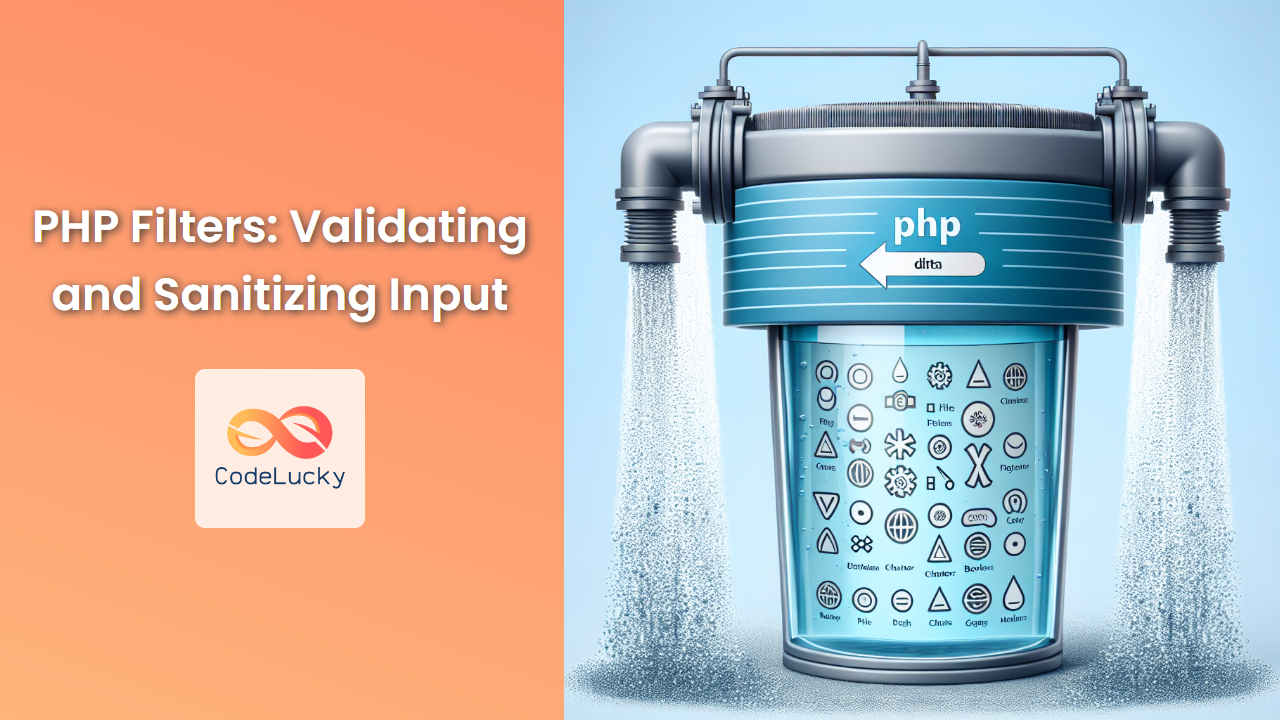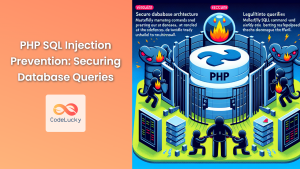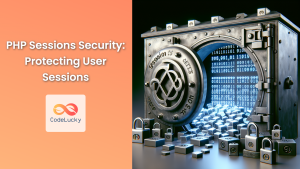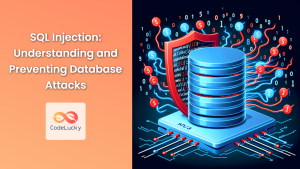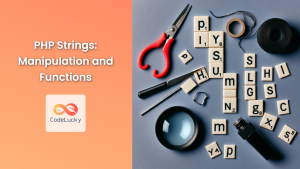In the world of web development, security is paramount. One of the most critical aspects of web security is ensuring that all user input is properly validated and sanitized before being processed or stored. PHP provides a powerful set of tools for this purpose: PHP Filters. In this comprehensive guide, we’ll dive deep into PHP Filters, exploring how to use them effectively to create more secure and robust applications.
Understanding PHP Filters
PHP Filters are built-in functions that allow developers to validate and sanitize external input. They act as a first line of defense against malicious data, helping to prevent common security vulnerabilities such as SQL injection and cross-site scripting (XSS) attacks.
🛡️ Key Benefits of PHP Filters:
- Improved security
- Simplified input handling
- Consistent data validation across your application
Let’s start by looking at the two main types of PHP Filters:
- Validation Filters: These check if the input data is in the correct format.
- Sanitization Filters: These remove any unwanted characters from the input data.
Validation Filters in Action
Validation filters are used to verify if a variable contains the expected type of data. Let’s explore some common validation filters with practical examples.
Example 1: Validating an Email Address
<?php
$email = "[email protected]";
if (filter_var($email, FILTER_VALIDATE_EMAIL)) {
echo "✅ Valid email address";
} else {
echo "❌ Invalid email address";
}
?>
In this example, FILTER_VALIDATE_EMAIL checks if the $email variable contains a valid email address format. The filter_var() function returns the validated data if it passes the filter, or false if it doesn’t.
Example 2: Validating an IP Address
<?php
$ip = "192.168.1.1";
if (filter_var($ip, FILTER_VALIDATE_IP)) {
echo "✅ Valid IP address";
} else {
echo "❌ Invalid IP address";
}
?>
Here, FILTER_VALIDATE_IP is used to check if $ip is a valid IP address. This filter can be particularly useful when working with network-related applications.
Example 3: Validating an Integer
<?php
$age = "25";
if (filter_var($age, FILTER_VALIDATE_INT) !== false) {
echo "✅ Valid integer";
} else {
echo "❌ Not a valid integer";
}
?>
In this case, FILTER_VALIDATE_INT checks if $age is a valid integer. Note that we use !== false in the condition because filter_var() returns 0 for the input “0”, which is a valid integer but evaluates to false in a boolean context.
Sanitization Filters: Cleaning Up Input
Sanitization filters are used to remove or encode unwanted characters from the input data. Let’s look at some practical examples of how to use these filters.
Example 4: Sanitizing an Email Address
<?php
$email = "[email protected]<script>";
$sanitized_email = filter_var($email, FILTER_SANITIZE_EMAIL);
echo "Original: $email\n";
echo "Sanitized: $sanitized_email";
?>
Output:
Original: user@example.com<script>
Sanitized: user@example.com
In this example, FILTER_SANITIZE_EMAIL removes all characters from the email address that are not allowed in a valid email address.
Example 5: Sanitizing a URL
<?php
$url = "https://www.example.com/page?param=value&<script>";
$sanitized_url = filter_var($url, FILTER_SANITIZE_URL);
echo "Original: $url\n";
echo "Sanitized: $sanitized_url";
?>
Output:
Original: https://www.example.com/page?param=value&<script>
Sanitized: https://www.example.com/page?param=value&
Here, FILTER_SANITIZE_URL removes all illegal characters from the URL.
Example 6: Sanitizing Integer Input
<?php
$input = "42 is the answer!";
$sanitized_input = filter_var($input, FILTER_SANITIZE_NUMBER_INT);
echo "Original: $input\n";
echo "Sanitized: $sanitized_input";
?>
Output:
Original: 42 is the answer!
Sanitized: 42
In this case, FILTER_SANITIZE_NUMBER_INT removes all characters except digits and plus/minus signs.
Advanced Usage: Combining Filters
PHP allows you to combine multiple filters for more complex validation and sanitization tasks. Let’s look at an example that combines validation and sanitization.
Example 7: Validating and Sanitizing a Float
<?php
$price = "19.99 USD";
// First, sanitize the input
$sanitized_price = filter_var($price, FILTER_SANITIZE_NUMBER_FLOAT, FILTER_FLAG_ALLOW_FRACTION);
// Then, validate the sanitized input
if (filter_var($sanitized_price, FILTER_VALIDATE_FLOAT) !== false) {
echo "✅ Valid price: $sanitized_price";
} else {
echo "❌ Invalid price";
}
?>
Output:
✅ Valid price: 19.99
In this example, we first use FILTER_SANITIZE_NUMBER_FLOAT with the FILTER_FLAG_ALLOW_FRACTION flag to remove all characters except digits, dot, and minus sign. Then, we validate the sanitized input using FILTER_VALIDATE_FLOAT.
Custom Filters with Regular Expressions
While PHP provides many built-in filters, sometimes you might need to create custom validation rules. You can do this using the FILTER_VALIDATE_REGEXP filter along with a custom regular expression.
Example 8: Custom Validation for a Product Code
Let’s say we want to validate a product code that should start with two letters followed by four digits.
<?php
$product_code = "AB1234";
$pattern = '/^[A-Z]{2}\d{4}$/';
if (filter_var($product_code, FILTER_VALIDATE_REGEXP, array("options"=>array("regexp"=>$pattern)))) {
echo "✅ Valid product code";
} else {
echo "❌ Invalid product code";
}
?>
In this example, we use FILTER_VALIDATE_REGEXP with a custom regular expression pattern to validate the product code.
Handling Form Input with PHP Filters
One of the most common use cases for PHP Filters is handling form input. Let’s look at a practical example of how to use filters to validate and sanitize form data.
Example 9: Processing a Registration Form
<?php
if ($_SERVER["REQUEST_METHOD"] == "POST") {
$username = filter_input(INPUT_POST, 'username', FILTER_SANITIZE_STRING);
$email = filter_input(INPUT_POST, 'email', FILTER_SANITIZE_EMAIL);
$age = filter_input(INPUT_POST, 'age', FILTER_VALIDATE_INT);
$errors = array();
if (empty($username)) {
$errors[] = "Username is required";
}
if (!filter_var($email, FILTER_VALIDATE_EMAIL)) {
$errors[] = "Invalid email format";
}
if ($age === false || $age < 18) {
$errors[] = "You must be at least 18 years old";
}
if (empty($errors)) {
echo "Registration successful!";
// Process the registration...
} else {
foreach ($errors as $error) {
echo "❌ $error<br>";
}
}
}
?>
<form method="post" action="<?php echo htmlspecialchars($_SERVER["PHP_SELF"]);?>">
Username: <input type="text" name="username"><br>
Email: <input type="text" name="email"><br>
Age: <input type="text" name="age"><br>
<input type="submit" value="Register">
</form>
In this example, we use filter_input() to sanitize and validate form inputs. We sanitize the username and email inputs, and validate the age input. Then, we perform additional checks and collect any errors. If there are no errors, we proceed with the registration process.
Best Practices for Using PHP Filters
To make the most of PHP Filters and ensure your applications are secure, consider the following best practices:
-
🔒 Always filter input, escape output: Use filters for all user inputs, and escape data when outputting to prevent XSS attacks.
-
🎯 Use the right filter for the job: Choose the appropriate filter based on the type of data you’re expecting.
-
🔍 Combine filters when necessary: For complex validation, use multiple filters or combine them with custom logic.
-
🚫 Don’t rely solely on client-side validation: Always validate data on the server-side, even if you have client-side validation.
-
📝 Document your filter usage: Make sure to comment your code explaining why specific filters are used.
-
🔄 Regularly update your PHP version: Newer versions of PHP often include improvements to the filter extension.
Conclusion
PHP Filters are a powerful tool in a developer’s arsenal for creating secure and robust web applications. By validating and sanitizing input data, you can significantly reduce the risk of security vulnerabilities and ensure that your application processes clean, expected data.
Remember, while PHP Filters are an excellent first line of defense, they should be part of a comprehensive security strategy that includes other best practices such as prepared statements for database queries, proper session management, and regular security audits.
By mastering PHP Filters, you’re taking a significant step towards becoming a more security-conscious developer and creating safer web applications for your users. Keep practicing, stay curious, and always prioritize security in your PHP development journey! 🚀🔒

